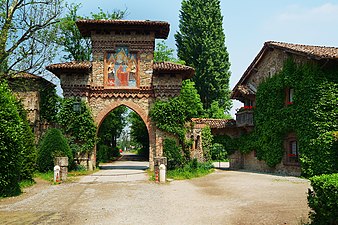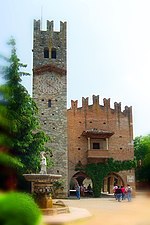
Luchino Visconti di Modrone, Count of Lonate Pozzolo was an Italian filmmaker, stage director, and screenwriter. A major figure of Italian art and culture in the mid-20th century, Visconti was one of the fathers of cinematic neorealism, but later moved towards luxurious, sweeping epics dealing with themes of beauty, decadence, death, and European history, especially the decay of the nobility and the bourgeoisie.

Vigevano is a town and comune in the province of Pavia, Lombardy in northern Italy. A historic art town, it is also renowned for shoemaking and is one of the main centres of Lomellina, a rice-growing agricultural district. Vigevano received the honorary title of city with a decree of Duke Francis II Sforza on 2 February 1532. It is famed for its Renaissance Piazza Ducale in the centre of the town.

The title Earl of Newburgh was created in the Peerage of Scotland in 1660 for James Livingston, 1st Viscount of Newburgh, along with the subsidiary titles Viscount of Kynnaird and Lord Levingston.

The Visconti of Milan are a noble Italian family. They rose to power in Milan during the Middle Ages where they ruled from 1277 to 1447, initially as Lords then as Dukes, and several collateral branches still exist. The effective founder of the Visconti Lordship of Milan was the Archbishop Ottone, who wrested control of the city from the rival Della Torre family in 1277.

Castell'Arquato is an Italian town located on the first hills of Val D’Arda in the province of Piacenza, in Emilia-Romagna, approximately 30 kilometres (19 mi) from Piacenza and 35 kilometres (22 mi) from Parma. Places nearby include Bacedasco, Vigolo Marchese, Fiorenzuola d'Arda, Lugagnano Val d'Arda, and Vernasca. It is a member of the I Borghi più belli d'Italia association.
Somma Lombardo is a town in the province of Varese, Lombardy, Italy. It received the honorary title of city with a presidential decree on 16 June 1959.

Ferno is a comune (municipality) in the Province of Varese in the Italian region Lombardy, located about 40 km (25 mi) northwest of Milan and about 35 km (22 mi) south of Varese. As of 31 December 2017, it had a population of 6,858 and an area of 8.5 km2 (3.3 sq mi).

Castano Primo is a city and comune in Province of Milan, in the Italian region Lombardy, located about 35 kilometres northwest of Milan.
Cesana Brianza is a municipality of 2,393 inhabitants in the Province of Lecco in Lombardy, about 40 kilometres (25 mi) north of Milan and 9 kilometres (5.6 mi) southwest of Lecco.

Luchino Visconti (also spelled Lucchino, 1287 or 1292 – January 24, 1349) was lord of Milan from 1339 to 1349. He was also a condottiero, and lord of Pavia.

Eriprando Visconti di Modrone, Count of Vico Modrone was an Italian film director, screenwriter, and producer. He was the nephew of the more famous Luchino Visconti.
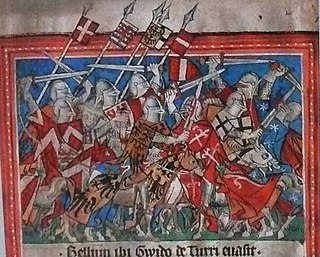
Guido della Torre was a Lord of Milan between 1302 and 1312.
Bonacossa Borri, also known as Bonaca, or Bonaccossi Bonacosta (1254–1321), was Lady of Milan by marriage from 1269 to 1321.

The Val Nure is the valley of the Nure river, a tributary of the Po. The valley lies almost entirely in the Province of Piacenza, in the Emilia-Romagna region of Italy. It forms part of the Comunità Montana Valli del Nure e dell'Arda.
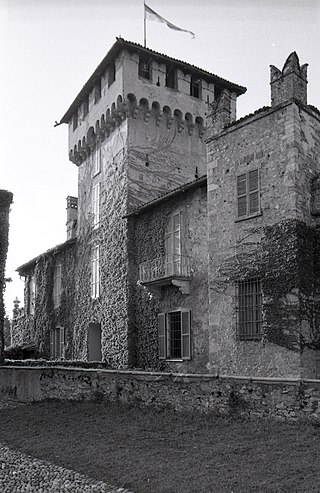
The Visconti Castle of Somma Lombardo is a medieval castle-palace in Somma Lombardo, Province of Varese, Lombardy, northern Italy.

The Visconti Castle of Massino is a medieval castle located on the Vergante hills in the municipality of Massino Visconti, Province of Novara, Piedmont, northern Italy. Since the 12th century it has been a possession and one of the preferred residences of the Visconti of Milan. At that time it was frequented by the family ancestor of the lords and dukes of Milan. Afterwards its property was transferred to other collateral branches of the lineage, from the initial Visconti di Massino to the current Visconti di San Vito.

The Visconti-Castelbarco Castle is a castle of mediaeval origin located in Cislago, Lombardy, Northern Italy. Since the 13th century it belonged to a cadet branch of the Visconti House. In the 18th century it became a property of the Castelbarco family.
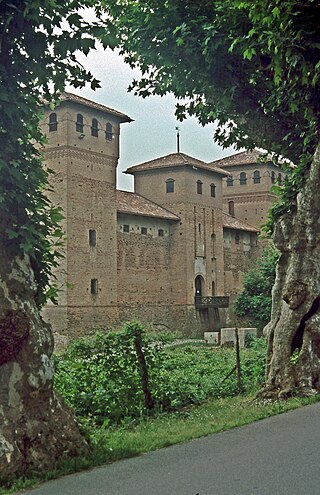
The Visconti Castle of Cherasco is a medieval castle in Cherasco, Piedmont, Northern Italy. It was built in the 14th century by Luchino Visconti, Lord of Milan, and partly reconstructed at the beginning of the 20th century.

Palazzo Visconti di Grazzano, also known as Palazzo Visconti di Modrone or Palazzo Bolagnos, is a historical palace located in the centre of Milan, in Via Cino del Duca no. 8.



